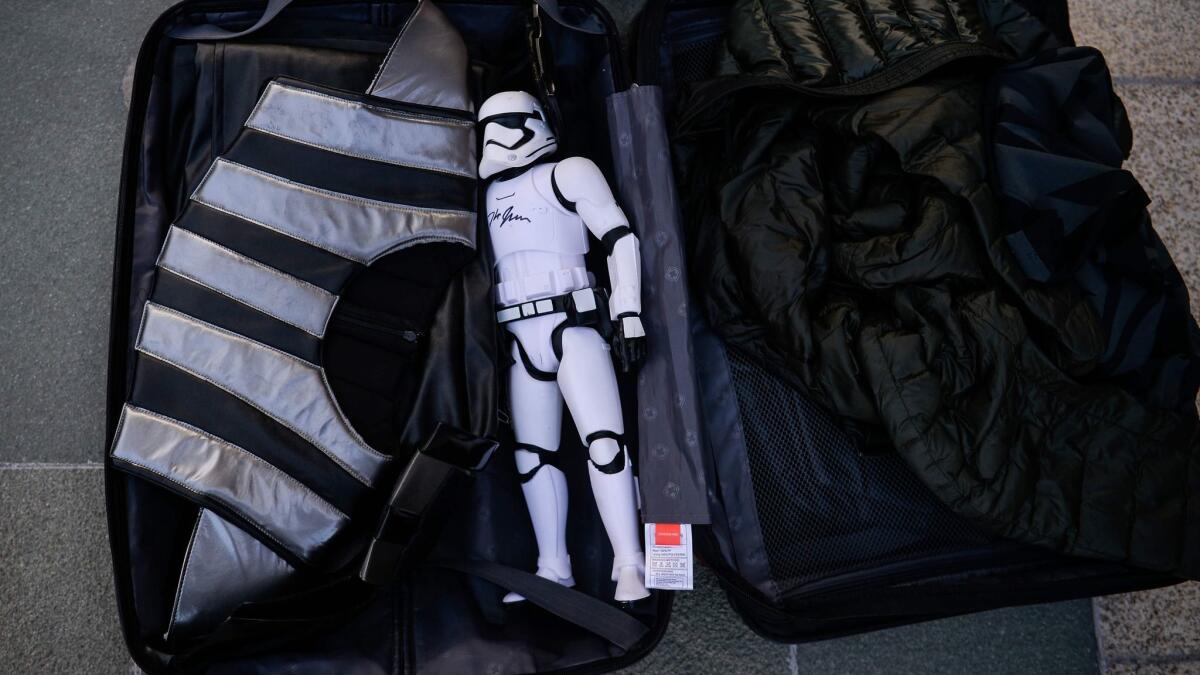‘Star Wars’ toy sales fall as movie tie-in fatigue sets in

The warning signs for the toy industry started last year when “Cars 3” — considered a surefire success — proved lackluster for licensees such as Mattel Inc.
Now, toy makers’ big bets on movie tie-ins look downright bleak. Playthings based on the “Star Wars” saga — the franchise that kicked off the whole phenomenon four decades ago — were down in 2017 even though a new film, “Star Wars: The Last Jedi,” came out in December during the all-important holiday shopping season.
Call it “Star Wars” burnout, or better yet “movie fatigue,” said Gerrick Johnson, an analyst for BMO Capital Markets. Hollywood and toy makers have fixated on toy-friendly films at a time when kids are increasingly turning to YouTube, Netflix and social media for entertainment.
More than 20 major films, including “The Last Jedi,” had robust toy-licensing programs last year. A decade ago, it was about half that. Movie attendance in the U.S. has dropped almost 14% in that span.
“There are so many screens now; kids aren’t just at the movies,” Johnson said. “A movie doesn’t have the same resonance it used to.”
Although “Star Wars” was still the top-selling toy line during the nine-week holiday period, sales fell compared with 2016 and the brand lost its No. 1 position for the year, according to data from market researcher NPD Group. Full-year 2016 numbers benefited from the pent-up demand from “Star Wars” fans who started buying merchandise after Walt Disney Co. rebooted the franchise with “Star Wars: The Force Awakens” in December 2015, as well as a second film, “Rogue One: A Star Wars Story,” released a year later.
“Star Wars is a force to be reckoned with in the toy industry,” Disney said in a statement. “It remains the leading film-driven property for the entire year.”
Sequel barrage
After a decade without a “Star Wars” film, Disney has released three movies since December 2015, and another one is coming in May. The latest installment, “The Last Jedi,” didn’t include many new memorable characters beyond those introduced in the preceding film, Johnson said. That left fans looking for newness elsewhere this year, leading to weaker results than expected, he said.
U.S. sales of the brand’s toys slowed in late 2017, Drew Crum, an analyst for Stifel Nicolaus & Co., wrote in a note to clients last week. This was despite “Last Jedi” being the top-grossing film released in the U.S. last year, raking in $596 million.
Adult collectors, who grew up with the brand, are still buying a lot of merchandise when the toys come out, but demand dies down afterward, according to Johnson.
That doesn’t bode well for Hasbro Inc., which has the main “Star Wars” toy partnership, or Jakks Pacific Inc., which has a secondary license. Malibu-based Jakks said that it couldn’t comment on “Star Wars” sales, but that merchandise tied to “Moana,” another Disney film, “remains very strong.” Hasbro declined to comment.
The “Star Wars” performance could hinder Disney’s bid to revive growth at its consumer products division, where sales fell 13% to $4.83 billion for the fiscal year that ended Sept. 30.
Dragged down
The September bankruptcy filing of Toys R Us Inc., which makes up about 15% of the market, added to the challenges for “Star Wars” sales growth this year, though the company continued to market the toys.
Visitors to the Toys R Us store on Los Feliz Boulevard in Los Angeles recently had plenty of “Star Wars” merchandise to choose from. A whole aisle included everything from a $3.99 Millennium Falcon Hot Wheels car to a $250 AT-ACT remote-controlled vehicle that walks and fires Nerf projectiles.
Tracey Gordon, a full-time mom from Glendale shopping at the store, said her three boys, ages 2 to 7, aren’t “Star Wars” fans even though she wore a Princess Leia costume on Halloween for years when she was younger.
“It’s a generational thing,” she said, adding that her nephew likes the toys largely because his dad “drags him to see the movies.”
Gigantic boon
For years, Hollywood’s push into comic-book heroes and other childhood fare was a gigantic boon for the toy industry. In the last decade, entertainment-related toys grew from 15% of the industry’s revenue to 38%, according to BMO.
The movie tie-ins helped propel the industry to some of its strongest growth in decades in 2015 and 2016, when “Star Wars” merchandise was the top-selling brand with more than $700 million in sales.
In the first half of 2017, tough comparisons to previous “Star Wars” sales contributed to declines in the building products and action figure categories, according to NPD. The market research firm, which is expected to report full-year sales numbers later this month, said in July that it was projecting 4.5% growth overall for the industry in 2017.
The original “Cars,” the 2006 animated film, was one of the stalwarts. Combining memorable characters with a classic kid plaything — a car — it remained a top-selling licensed brand for years after its release. Disney opened a Cars Land attraction at its California Adventure park in Anaheim in 2012 that drew hours-long wait times for its signature ride.
But the third film came out in a crowded field, followed over the next several weekends by the latest “Transformers,” “Despicable Me” and “Spider-Man” movies. It didn’t help that “Cars 3” got an average score of 68% from critics at RottenTomatoes.com.
More coming
Even more toy-licensed films are scheduled, including the prequel “Solo: A Star Wars Story” and new “Transformers,” “Fantastic Beasts,” “Jurassic World” and superhero fare. The lesson toy makers will draw from the 2017 slate is that they can’t just rely on the movie to do the marketing anymore.
“There is a new paradigm,” Johnson said. “Just because there is a movie with a toy tie-in doesn’t necessarily mean it’s going to work. It used to mean it would work.”
Townsend and Palmeri write for Bloomberg.
More to Read
Inside the business of entertainment
The Wide Shot brings you news, analysis and insights on everything from streaming wars to production — and what it all means for the future.
You may occasionally receive promotional content from the Los Angeles Times.










